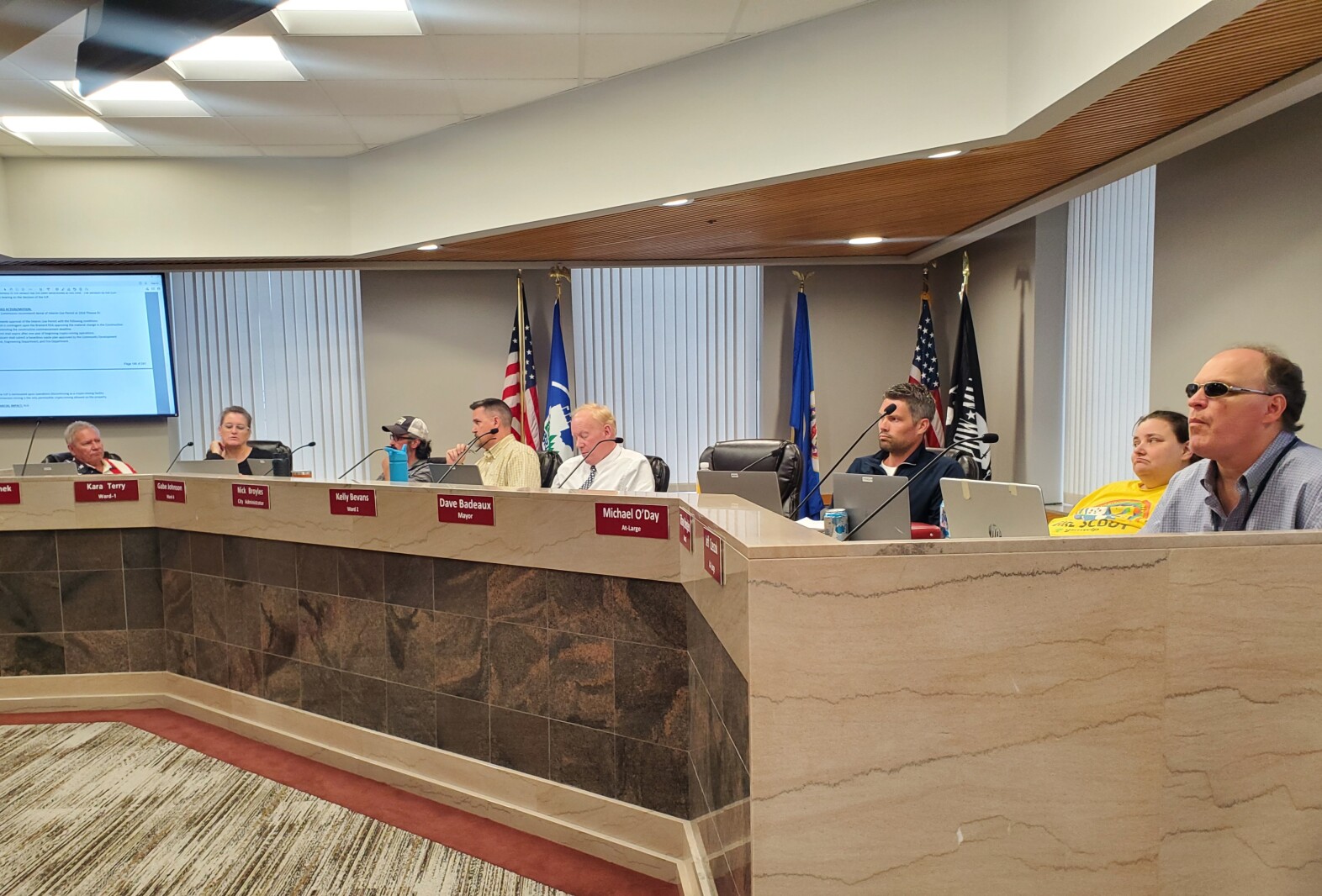News
Encryption Proposal Rejected in Brainerd – Brainerd Dispatch

BRAINERD — It’s time to go back to the drawing board for a cryptocurrency mining facility that wants to land in Brainerd.
The words “devil’s spawn” were used Monday, July 2, to describe the practice, which council members say is inconsistent with the city’s master plan. Not even a 12-foot concrete wall would entice city officials. They voted unanimously to deny a temporary use permit that would have allowed the facility to operate in the industrial park.
“For me, when I know more, I do better,” City Councilwoman Kara Terry said Monday. “When it was first proposed, it may have made sense, and there was limited information about the impacts. Now we understand the impacts better and how this additional storage doesn’t fit with what I see as the right direction for the city of Brainerd.”
The permit request came from VCV Digital Infrastructure, which sought approval for outdoor storage as a primary use on the property at 1918 Thiesse Drive. The company proposed building 26 40-foot-long storage containers to house data machines and cooling towers for the operation. Council members granted the company a permit in 2022 for 12 20-foot-long containers and 12 cooling fans, but that permit expired after VCV failed to make any improvements to the land within a year of issuance.
When the new permit was presented to officials, the Planning Commission voted 3-2 to recommend denying the permit after hearing from several residents who live near the industrial park and who were concerned about the facility’s noise impact. City Council members ordered a noise study to determine how nearby residents could potentially be affected. The staff study, based on projected decibel levels and information from the Minnesota Pollution Control Agency, showed that the projected noise was within MPCA standards.
“However,” the staff report states, “there are many other factors that were not considered in this study that could increase or decrease decibel readings, such as vegetation, above- or below-average temperatures, humidity, air pressure, topography, and proximity to containers.”
Staff members recommended approval of the permit Monday night, as Community Development Director James Kramvik told the council that the permit was only for outdoor storage as a primary use, which is a permitted use in that zoning district. The permit was not specifically for a cryptocurrency mining facility, although that is the applicant’s intent.
The approval recommended by the staff was accompanied by several conditions on the permit, which would:
- Set an expiration date of one year from the start of cryptocurrency mining operations.
- Require the developer to submit a hazardous waste disposal plan for the oil used in the immersion extraction process.
- Terminate the permit upon cessation of cryptocurrency activity on the property.
- Allow only immersion mining on the site. Immersion mining is a cryptocurrency mining method where data machines are immersed in oil. This technique is quieter than open-air mining, with the only noise coming from cooling fans.
- Require that noise levels do not exceed standards set by the MPCA.
- Request that the property owner conduct an acoustical study once the facility is operational.
Spectators fill the Brainerd City Council chambers on Monday, July 1, 2024.
Theresa Bourke / Sending to Brainerd
Councilman Mike O’Day proposed an additional condition: a wall.
A 12-foot-high concrete wall around the entire property, he said, is the only way to vote in favor of the permit.
City Councilman Jeff Czeczok said he likes the idea in theory, but would prefer the requirement to be less specific and call for a sound-absorbing wall of some kind, not knowing whether concrete would be the best material for the job.
Council President Kelly Bevans and Councilman Gabe Johnson agree.
Kramvik said one condition could be additional soundproofing, although City Attorney Joe Langel disagrees.
A wall that size around the entire lot, Langel said, would require a council-approved waiver under city code. He questioned why the council would create a mandatory condition that would normally require a waiver.
“Whatever kind of conditions you put into this really have to come from your code to have a basis for this,” Langel said. “… I’m not aware of anything in the code that requires huge 10- to 12-foot noise walls.”
Langel said he did not intend to support either side of the issue, but wanted to make sure the board paid attention to all the conditions set out.
O’Day’s motion to approve the permit with the 12-foot concrete wall was defeated by a vote of 2-5, with only he and City Councilwoman Tiffany Stenglein in favor.
Stenglein then introduced another motion, to approve the permit with the conditions set by staff, but changing the permit’s expiration date to December 31, 2025. His motion did not include any soundproofing measures and died for lack of a second.
Johnson then attempted to introduce a motion, moving to approve the permit with all staff conditions and the requirement for a staff-approved sound barrier.
Czeczok said he would support the motion, despite being against cryptocurrency mining in general.
“I don’t like crypto mining at all. I think it’s the devil’s spawn. I think this whole thing is a disaster,” he said. “I’m going to support the motion because we have a job to do as council members. I don’t want to see the city suffer to protect something that is completely unknown at this time.” The permit, he added, would come with several conditions to mitigate any potential problems.
“As much as I would like to see this situation go away and never come back, we need to be accountable to our taxpayers, our citizens and our neighbors,” Czeczok said.
The third motion was defeated by a vote of 3 to 4, with Johnson, Stunek, O’Day and Terry voting against it.
Terry moved the final motion, denying the permit due to inconsistencies with the master plan and environmental and noise concerns from nearby residents.
Terry, who lives in South Brainerd, said he knows the neighborhood is noisy, with UPS trucks, the recycling plant and large beverage trucks coming and going. He said he bought the house knowing those noise factors were there and noted that the noise stops at night and usually on Sundays, while the cryptocurrency mining facility would operate 24/7. He also noted the city’s desire to attract companies that create jobs in Brainerd, which cryptocurrency mining doesn’t, as well as local contractors to build the facility.
Terry’s motion to deny permission was carried unanimously.
The applicant has the opportunity to appeal the board’s decision to a district court within 30 days.
THERESA BOURKE can be contacted at
theresa.bourke@brainerddispatch.com
or 218-855-5860. Follow her on Twitter at
www.twitter.com/DispatchTheresa
.
News
Cryptocurrency Price August 1: Bitcoin Dips Below $65K; Solana, XRP Down Up To 8%

Major cryptocurrencies fell in Thursday trading following the Federal Reserve’s decision to keep its key interest rate unchanged. Overnight, the U.S. Federal Reserve kept its key interest rate at 5.25-5.5% for the eighth consecutive time, as expected, while also signaling the possibility of a rate cut at its next meeting in September. The unanimous decision by the Federal Open Market Committee reflects a continued wait-and-see approach as it monitors inflation trends.
CoinSwitch Markets Desk said: “Bitcoin has fallen below $65,000 after the US Federal Reserve announced it would keep interest rates unchanged. However, with markets now anticipating rate cuts at the next Federal Reserve meeting in September, the outlook for a Bitcoin rally by the end of the year has strengthened.”
Meanwhile, CoinDCX research team said: “The crypto market has plunged after the Fed decision. Tomorrow’s US unemployment rate announcement is expected to induce more volatility, with the ‘actual’ figure coming in higher than the ‘expected’ one, which is positive for cryptocurrencies.”
At 12:21 pm IST, Bitcoin (BTC) was down 3.2% at $64,285, while Ethereum was down nearly 4.5% at $3,313. Meanwhile, the global market cryptocurrency The market capitalization fell 3.6% to around $2.3 trillion in the last 24 hours.
“Bitcoin needs to clear its 200-day EMA at $64,510 to consolidate further. Otherwise, a retest of $62,000 could be in the cards,” said Vikram Subburaj, CEO of Giottus.
Altcoins and meme coins, such as BNB (3%), Solana (8%), XRP (5.7%), Dogecoin (5%), Cardano (4.6%), Avalanche (4.3%), Shiba Inu (3.8%), Polkadot (3.4%), and Chainlink (4%) also saw declines.
The volume of all stablecoins is now $71.64 billion, which is 92.19% of the total cryptocurrency market volume in 24 hours, according to data available on CoinMarketCap. Bitcoin’s dominance is currently 54.99%. BTC volume in the last 24 hours increased by 23.3% to $35.7 billion.
(Disclaimer: Recommendations, suggestions, opinions and views provided by experts are personal. They do not represent the views of the Economic Times)
(You can now subscribe to our ETMarkets WhatsApp Channel)
News
Altcoins WIF, BONK, RUNE, JUP Down 10% While Bitcoin Drops 4%

Altcoins dogwifhat, Bonk, THORChain, and Jupiter have suffered losses of more than 10%, while Bitcoin is down 4% in the last 24 hours.
After a period of relative calm yesterday, July 31, Bitcoin (BTC) price action has seen a drastic change as the cryptocurrency dropped by more than $3,500, bringing its value to $63,300. At the same time, altcoins mirrored this trend, with the total value of liquidated positions rising to nearly $225 million over the course of the day.
Initially, the week started on a positive note for Bitcoin, which reached its highest point since early June, hitting $70,000. However, this peak was short-lived, as it was quickly rejected, leading to a substantial decline, with Bitcoin falling below $65,500.
The cryptocurrency managed to regain some stability, trading comfortably at around $66,800. However, following a Press conference According to Federal Reserve Chairman Jerome Powell, the value of Bitcoin has fallen again to $64,300, down more than 3% in 24 hours.
BTC Price Chart 24 Hours | Source: crypto.news
The recession coincided with a relationship from the New York Times stating that Iran had called for retaliatory measures against Israel following the assassination of Hamas leader Ismail Haniyeh in Tehran, increasing the risk of further conflict in the region.
Meanwhile, on the economic front, the Federal Reserve decided to keep its benchmark interest rates in place, offering little information on a planned September rate cut. Powell also hinted that while no concrete decisions have been made on the September adjustment, there is growing consensus that a rate cut is likely.
Amid Bitcoin’s decline, altcoins have suffered even more significant losses. For example, dogwifhat (Wife) saw a 12.4% drop and (DISGUST) has suffered a 10% drop. Other altcoins such as THORChain (RUNE) also fell by 10%, while Jupiter (JUPITER) and the Ethereum naming service (ENS) decreased by 8% and 9% respectively.
Among the largest-cap cryptocurrencies, the biggest losers are Solana (SOL) with a decrease of 8%, (Exchange rate risk) down 6%, Cardano (ADA) down 4%, and both Ethereum (ETH) and Dogecoin (DOGE) recording a decrease of 4.4%.
Data from CoinGlass indicates that approximately 67,000 traders have been negatively impacted by this increased volatility. BTC positions have seen $61.85 million in liquidations, while ETH positions have faced $61 million. In total, the value of liquidated positions stands at $225.4 million at the time of writing.
News
Riot Platforms Sees 52% Drop in Bitcoin Production in Q2

Bitcoin mining firm Riot Platforms has released its second-quarter financial results, highlighting a decline in cryptocurrency mined due to the recent halving.
Colorado-based Bitcoin (BTC) mining company Riot platforms revealed its second quarter financial results, highlighting a significant reduction in mined cryptocurrencies attributed to the recent halving event that took place in early April.
The company reported total revenue of $70 million for the quarter ended July 31, a decline of 8.7% compared to the same period in 2023. Riot Platforms attributed the revenue decline primarily to a $9.7 million decrease in engineering revenue, which was partially mitigated by a $6 million increase in Bitcoin extraction income.
During the quarter, the company mined 844 BTC, representing a decline of over 50% from Q2 2023, citing the halving event and increasing network difficulty as major factors behind the decline. Riot Platforms reported a net loss of $84.4 million, or $0.32 per share, missing Zacks Research forecast a loss of $0.16 per share.
Halving increases competitive pressure
The Colorado-based firm said the average cost of mining one BTC in the second quarter, including energy credits, rose to $25,327, a remarkable 341% increase from $5,734 per BTC in the same quarter of 2023. Despite this significant increase in production costs, the firm remains optimistic about maintaining competitiveness through recent deals.
For example, following the Recent acquisition Cryptocurrency firm Block Mining, Riot has increased its distributed hash rate forecast from 31 EH/s to 36 EH/s by the end of 2024, while also increasing its 2025 forecast from 40 EH/s to 56 EH/s.
Riot Platforms Hashrate Growth Projections by 2027 | Source: Riot Platforms
Commenting on the company’s financials, Riot CEO Jason Les said that despite the halving, the mining company still managed to achieve “significant operational growth and execution of our long-term strategy.”
“Despite this reduction in production available to all Bitcoin miners, Riot reported $70 million in revenue for the quarter and maintained strong gross margins in our core Bitcoin mining business.”
Jason Les
Following its Q2 financial report, Riot Platforms shares fell 1.74% to $10.19, according to Google Finance data. Meanwhile, the American miner continues to chase Canadian rival Bitfarms, recently acquiring an additional 10.2 million BITF shares, increasing its stake in Bitfarms to 15.9%.
As previously reported by crypto.news, Riot was the first announced a $950 million takeover bid for Bitfarms in late May, arguing that Bitfarms’ founders were not acting in the best interests of all shareholders. They said their proposal was rejected by Bitfarms’ board without substantive engagement.
In response, Bitfarms She said that Riot’s offer “significantly understates” its growth prospects. Bitfarms subsequently implemented a shareholder rights plan, also known as a “poison pill,” to protect its strategic review process from hostile takeover attempts.
News
Aave Price Increases Following Whales Accumulation and V3.1 Launch

Decentralized finance protocol Aave is seeing a significant spike in whale activity as the market looks to recover from the recent crash that pushed most altcoins into key support areas earlier this week.
July 31, Lookonchain shared details indicating that the whales had aggressively accumulated Aave (AAVE) over the past two days. According to the data, whales have withdrawn over 58,848 AAVE worth $6.47 million from exchanges during this period.
In one instance, whale address 0x9af4 withdrew 11,185 AAVE worth $1.23 million from Binance. Meanwhile, another address moved 21,619 AAVE worth over $2.38 million from the exchange and deposited the tokens into Aave.
These withdrawals follow a previous transfer of 26,044 AAVE from whale address 0xd7c5, amounting to over $2.83 million withdrawn from Binance.
AAVE price has surged over 7% in the past 24 hours amid buy-side pressure from these whales. The DeFi token is currently trading around $111 after jumping over 18% in the past week.
Recently, the price of AAVE increased by over 8% after Aave founder Marc Zeller announced a proposed fee change aimed at adopting a buyback program for AAVE tokens.
Aave v3.1 is available
The total value locked in the Aave protocol currently stands at around $22 billion. According to DeFiLlamaApproximately $19.9 billion is on Aave V3, while the V2 chain still holds approximately $1.9 billion in TVL and V1 approximately $14.6 million.
Aave Labs announced Previously, Aave V3.1 was made available on all networks with active Aave V3 instances.
V3.1 features improvements that are intended to improve the overall security of the DeFi protocol. The Aave DAO governance has approved the v3.1 improvements, which also include operational efficiency and usability for the network.
Meanwhile, Aave Labs recently outlined a ambitious roadmap for the projectwith a 2030 vision for Aave V4, among other developments.
-

 Regulation12 months ago
Regulation12 months agoRipple CTO and Cardano founder clash over XRP’s regulatory challenges ⋆ ZyCrypto
-

 Regulation10 months ago
Regulation10 months agoNancy Pelosi Considers Supporting Republican Crypto Bill FIT21 – London Business News
-

 Videos11 months ago
Videos11 months agoCryptocurrency News: Bitcoin, ETH ETF, AI Crypto Rally, AKT, TON & MORE!!
-

 Regulation11 months ago
Regulation11 months agoBitcoin’s future is ‘bleak’ and ripe for regulation, says lead developer
-

 News8 months ago
News8 months agoAave Price Increases Following Whales Accumulation and V3.1 Launch
-

 Regulation8 months ago
Regulation8 months agoSouth Korea Imposes New ‘Monitoring’ Fees on Cryptocurrency Exchanges
-

 Regulation8 months ago
Regulation8 months agoA Blank Sheet for Cryptocurrencies: Kamala Harris’ Regulatory Opportunity
-

 Regulation8 months ago
Regulation8 months agoCryptocurrency Regulations in Slovenia 2024
-

 News11 months ago
News11 months agoThe trader earned $46 million with PEPE after reaching a new ATH
-

 Regulation11 months ago
Regulation11 months agoCrypto needs regulation to thrive: Tyler Cowen
-

 Blockchain11 months ago
Blockchain11 months agoSolana ranks the fastest blockchain in the world, surpassing Ethereum, Polygon ⋆ ZyCrypto
-

 Blockchain11 months ago
Blockchain11 months agoSolana Surpasses Ethereum and Polygon as the Fastest Blockchain ⋆ ZyCrypto

















